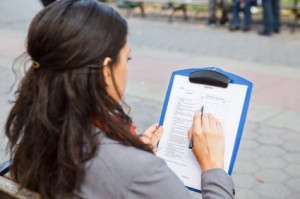Natural disasters and emergencies may not normally occur while you are at home where your emergency supplies and food storage are kept. Because of this, it is important to have an
emergency plan for the various places your family spends time. Our homes, schools and workplaces should have site-specific preparations for an emergency.

Emergency Preparedness at Work
Think about what you have at your office that will help you get through an emergency. Maybe you have a candy bar or a package of stale donuts in your desk drawer or maybe just an old pack of chewing gum. At leas—t that's a start! Do you even know if your company has an evacuation plan or how to use that plan? The following are some simple ideas to help you feel safe at work, even during an emergency.
Keep a backpack or duffle bag of your own personal supplies in a desk drawer. This pack could include the following:
-
Flashlight with extra batteries
-
Emergency bag or
blanket (very compact and made of a special material that reflects up to 90% of your body heat)
- Food (
high calorie food bars,
MREs, granola bars,
fruit bars, candy bars,
crackers, fruit leather,
raisins, nuts, prepackaged foods, etc.)
-
Water pouches or juice boxes
- Pair of walking shoes
-
Multi function knife (NOT in school kits; in works kits, check with your H.R. department for approval)
-
Mini first aid kit (adhesive bandages, rolled bandages for sprains, pain reliever, any medication you need, gauze, antiseptic wipes, antibiotic first aid cream, etc.)
In addition to packing a small
survival kit, here are some other important things you can do:
- Read your company's
evacuation plan. If your company doesn't have one, volunteer to prepare one. Make sure there is a good designated meeting location and every employee knows where to go.
- Make sure you are aware of the exit routes in your building.
- Know where the fire extinguishers and first aid kits are located.
- Note the locations of stairways as you walk from room to room.
- Carry a card in your wallet or purse that has important phone numbers including the number of your out-of-state phone contact.
- Keep the area under your desk free of trash cans and clutter. This area is the best place to secure yourself in the event of an earthquake.
- Don't count on being able to get back to your desk for personal supplies if you are away when an emergency occurs. Store additional supplies in your car, such as an
emergency car kit.
- Be sure you discuss a meeting plan with your family so they know where to go and when to expect you.

Emergency Preparedness at School
Schools should already have an emergency plan to make sure your children are safe, but do you know enough about it to explain it to your children? The following are ideas to help you and your children feel safe away from home during an emergency.
Contact your school district to Replace out about their emergency plan and the policy on how children will be released from school. Some schools already have an emergency classroom kit. Replace out where it is located. Also, give your child a small disaster kit like the Shield School Emergency Kit for them to keep in their locker or desk.
The Shield kit contains:
- 1 Aqua Blox prepackaged water (8.45 oz.)
- 1 400-Calorie Millennium Food Bar
- 1 18-hour warmer
- 1 Emergency poncho
- 1 Emergency Sleeping Bag
You can also customize the kit by adding the following:
-
Flashlight with extra batteries
- Additional food (
high calorie food bars,
MREs, granola bars,
fruit bars,
crackers, candy bars, fruit leather,
raisins, nuts, prepackaged foods, etc.)
- Additional
Water pouches or juice boxes
- Comic book or toy for stress-relief or to alleviate boredom
-
Mini first aid kit (adhesive bandages, rolled bandages for sprains, pain reliever, any medication you need, gauze, antiseptic wipes, antibiotic first aid cream, etc.)Make sure your child knows how to use these first aid items properly.
Help your child understand when they are allowed to use their disaster kit and exactly how to use it. You should also include an identification card with their name, address, telephone number, emergency telephone numbers, birth date, and a reminder note to stay calm. For more information on helping your child prepare for an emergency review our Insight article, "
Child Safety."

Make a family fun night out of getting everyone prepared. Here are some ideas to help your family feel prepared wherever they are:
- Discuss your family
emergency evacuation plan from your home in case of fire or other disaster, and a specific location to meet.
- Help your children memorize important phone numbers.
- Teach them the location of the nearest police and fire stations and their phone numbers.
- Know the route to the nearest hospital emergency room.
- Meet with your neighbors and Replace out who has medical experience and have a training night.
- Give spare keys to your trusted neighbors.
- Show your children where the utility shutoffs are and how to shut them off.
- Keep your car's gas tank at least half full.
- Familiarize your children with emergency preparedness products by going through your home emergency kit.
It is important to think ahead and communicate with others in advance. By following these guidelines you will be better prepared to safely reunite with loved ones during an emergency.



